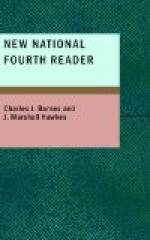Do not interrupt a pupil while reading until a thought or sentence is completed, since such a course tends to make reading mechanical and deprive it of expression.
Errors in time, force of utterance, emphasis, and inflection should be carefully corrected, and then the passage read over again.
The “Directions for Reading” throughout the book are intended to be suggestive rather than exhaustive, and can be added to as occasion requires.
The “Language Lessons” in this book, should not be neglected. They contain only such matter as is necessary to meet the requirements of pupils.
Words and expressions not readily understood, must be made intelligible to pupils. This has been done in part by definitions, and in part by interpreting some of the difficult phrases.
After the habit of acquiring the usual meaning has been formed, the original meaning of those words which are made up of stems modified by prefixes or affixes should be shown.
The real meaning of such words can be understood far better by a study of their formation, than by abstract definitions. It will be found, also, that pupils readily become interested in this kind of work.
As the capabilities of classes of the same grade will differ, it may sometimes occur that a greater amount of language work can be done effectively than is laid down in this book. When this happens, more time can be devoted to such special kinds of work as the needs of the classes suggest.
Constant drill upon the analysis of lessons, varied at times by the analysis of short stories taken from other sources and read to the class, will develop the reasoning faculties of pupils and render the writing of original compositions a comparatively easy exercise.
Encourage the habit of self-reliance on the part of pupils. Original investigation, even if followed at first by somewhat crude results, is in the end more satisfactory than any other course.
The Definitions (pages 373-382) and the List of Proper Names (pages 383 and 384) may be used in the preparation of the lessons.[01]
When exercises are written, particular care should be required in regard to penmanship, correct spelling, punctuation, and neatness.
[01] “The Definitions” are found at the end of the text, however “the List of Proper Names” has not been included in this production.
PHONIC CHART.
VOWELS.
a as in lake a " " at a " " far a " " all a " " care a " " ask a as in what e " " be e " " let i " " ice i " " in o " " so o as in box u " " use u " " up u " " fur oo " " too oo " " look
DIPHTHONGS.
oi, oy (unmarked), as in oil, boy ou, ow " " " out, now




